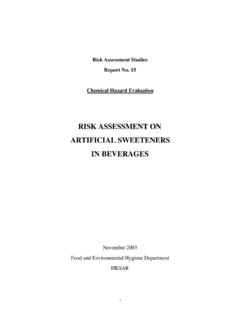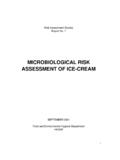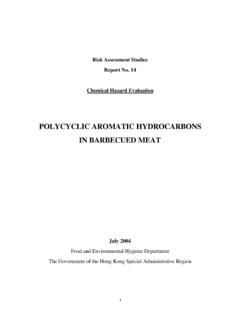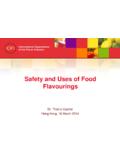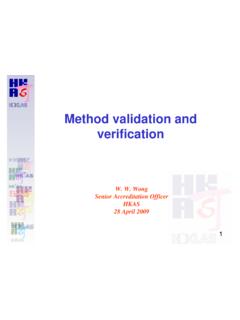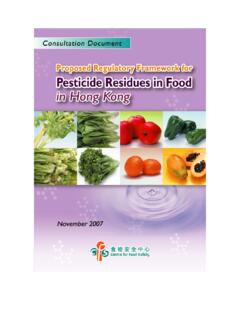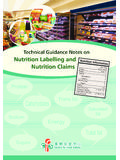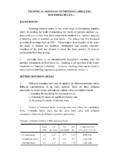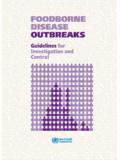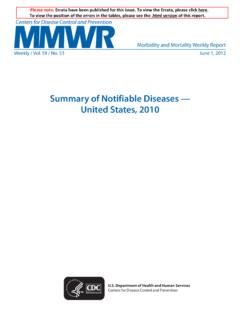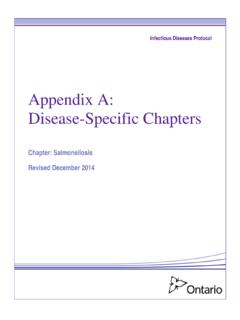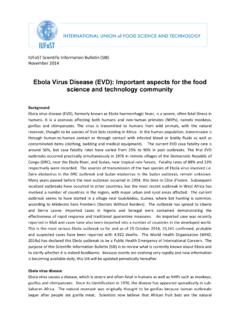Transcription of Risk Assessment Studies Report No - 食物安全中心
1 Risk Assessment Studies Report VIBRIO SPECIES IN SEAFOOD August 2005 Food and Environmental Hygiene Department The Government of the Hong Kong Special Administrative Region ii Correspondence: Risk Assessment Section Food and Environmental Hygiene Department 43/F, Queensway Government Offices, 66 Queensway, Hong Kong Email: This is a publication of the Food and Public Health Branch of the Food and Environmental Hygiene Department (FEHD) of the Government of the Hong Kong Special Administrative Region. Under no circumstances should the research data contained herein be reproduced, reviewed or abstracted in part or in whole, or in conjunction with other publications or research work unless a written permission is obtained from FEHD. Acknowledgement is required if other parts of this publication are used. iiiTable of Contents Abstract Objective Introduction Vibrio Species V.
2 Cholerae V. parahaemolyticus V. vulnificus Vibrio spp. and Seafood Factors affecting growth and survival of vibrios in seafood Local foodborne Disease Figures V. parahaemolyticus Food Poisoning Cholera Cases Study on the Ecology of V. cholerae in Local Marine Water and Live Seafood Discussion Conclusion and Recommendations Advice to Trade Advice to Public Reference Table 1: V. parahaemolyticus Food Poisoning by Food Group (1999 to 2003) Table 2: V. parahaemolyticus Food Poisoning Outbreaks Due to Consumption of Seafood (1999 to 2003) Table 3: Contributing Factors of V. parahaemolyticus Food Poisoning Outbreaks due to Consumption of Seafood (1999 to 2003) Table 4: Local Cholera Cases by Food Group (1999 to 2003) Annex I: Selected Sites for Water Sampling Page 2 3 3 11 14 17 18 22 11 12 13 14 25 1 Risk Assessment Studies Report VIBRIO SPECIES IN SEAFOOD 2 Abstract Vibrios are associated with live seafood as they form part of the indigenous microflora of the marine environment.
3 foodborne infections with Vibrio spp. are common in Asia. In Hong Kong, V. parahaemolyticus continued to be thetop causative agent among all the reported food poisoning outbreaks in recent years. According to the figures provided by the Department of Health (DH), 552confirmed V. parahaemolyticus food poisoning outbreaks affecting 2725 persons were reported during 1999 to 2003. Among these 552 outbreaks, 313 ( ) were due to consumption of seafood. Inadequate cooking ( ) and contamination by raw food ( ) were the main contribution factors for these cases. Cholera appears as sporadic diseases in Hong Kong. Information from the DH showed that there were totally 49 local cholera cases reported during 1999 to 2003. The suspected food item was identified in about half of the cases, of which, seafood accounted for about 80%.
4 According to a Study on the Ecology of V. cholerae in Marine Water and Live Seafood, water samples taken from typhoon shelters and shoreline waters were found to have higher chance of detecting V. cholerae from open waters and fish culture zones. Water samples which were tested positive for V. cholerae also have higher E. coli counts. The results also implied that if V. cholerae is the concern for the abstraction ofseawater for keeping live seafood, both the site where the water is abstracted and the E. coli count are important parameters to be considered. Good manufacturing practices should always be observed by the trade to minimise the risk of cholera and vibrio food poisoning associated with the consumption of seafood products. Hygienic quality of fish tank water in particular the source water for keeping live seafood is also important.
5 3 Risk Assessment Studies Report Vibrio species in Seafood OBJECTIVE The aims of this paper are to evaluate the local situation of Vibrio species (spp.) in seafood products and to make recommendations to reduce risk associated with the consumption of seafood. INTRODUCTION 2. Seafood is a nutritious food that constitutes one of the desirable components of a healthy diet. Nevertheless, there are health risks associated with the consumption of seafood. One of the major risks involves the consumption of raw or undercooked seafood that may be naturally contaminated by foodborne pathogens present in the marine environment. Such risk is further increased if the food is mishandled during processing where pathogens could multiply exponentially under favourable conditions.
6 3. In contrast to most other foodborne pathogens, Vibrio spp. have the aquatic habitat as their natural niche. As a result, vibrios are 4most commonly associated with seafood as natural contaminants. foodborne infections with Vibrio spp. are common in Asia1, including Hong Kong. Vibrio Species 4. Vibrio spp. are Gram-negative, facultatively anaerobic motile curved rods with a single polar flagellum. Among the members of the genus, 12 species have so far been reported to be pathogenic to humans, where eight of these may be associated with foodborne infections of the gastrointestinal Most of these foodborne infections are caused by V. parahaemolyticus and V. cholerae, and to a lesser extent by V. The following paragraphs highlighted the characteristics of these three vibrios.
7 V. cholerae 5. Among the vibrios, V. cholerae is of most concern because of its ability to cause cholera. V. cholerae can be divided into serogroups on the basis of the O antigen. Of the more than 200 V. cholerae serogroups that exist, only O1 and O139 are associated with the epidemiological features and clinical syndrome of cholera. However, organisms of V. cholerae serogroups other than O1 and O139 (non-O1 non-O139 serogroups) have been associated with sporadic cases of foodborne outbreaks of gastroenteritis, but have not spread in epidemic The most important virulence factor associated with V. cholerae O1 and O139 5serogroups is the cholera toxin. Non-O1 non-O139 serogroups are generally nontoxigenic. 6. Cholera remains a public health threat globally causing hundreds of thousand cases every year.
8 However, this threat is much reduced in places with safe water supply and good standards of hygiene and sanitation. Cholera is an acute intestinal infection. Its incubation period ranges from a few hours to five days, usually two to three days. Although asymptomatic infection is more common, clinical illness may be exhibited. Symptoms include a sudden onset of profuse painless watery diarrhoea that can quickly lead to rapid dehydration, acidosis, circulatory collapse, hypoglycaemia in children, renal failure and death if treatment is not promptly given. Nausea and vomiting also occurs early in the course of illness. Cholera is transmitted through ingestion of food or water contaminated with the bacterium, especially via faeces or vomitus of infected persons, directly or indirectly.
9 Human volunteer feeding Studies utilising healthy individuals have demonstrated that the infective dose is approximately one million organisms. However, conditions which decrease acidity in the stomach such as antacid consumption markedly lowers the infective 7. Gastroenteritis caused by V. cholerae non-O1 non-O139 serogroups is milder than cholera. The incubation period ranges from 12 to 24 hours in outbreaks4 and is characterised by diarrhoea and abdominal cramps. About 70% of infected individuals will have fever. Nausea and vomiting are reported in 21% and bloody diarrhoea in 25% of Cases of non-O1 non-O139 gastroenteritis are usually linked to consumption of raw or undercooked seafood, particularly shellfish.
10 It is suspected that large numbers (more than one million) of the organism must be ingested to cause 8. V. cholerae is a mesophilic organism that grows in the temperature range of 10 to 43 C, with optimum growth at 37 C. The pH optimum for growth is although it can grow in the pH range of to V. cholerae can grow in the salt range of to NaCl, while optimum is V. parahaemolyticus 9. V. parahaemolyticus was first identified as a foodborne pathogen in Japan in the 1950s. By the late 1960s and early 1970s, V. parahaemolyticus was recognised as a cause of diarrhoeal disease worldwide, although most common in Asia and the United In Hong Kong, V. parahaemolyticus continued to be the top causative agent among all the reported food poisoning outbreaks in recent ,9,10,11,12 10.
